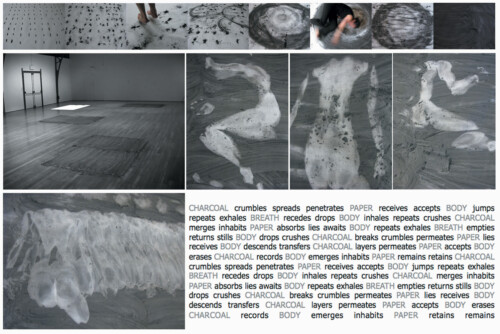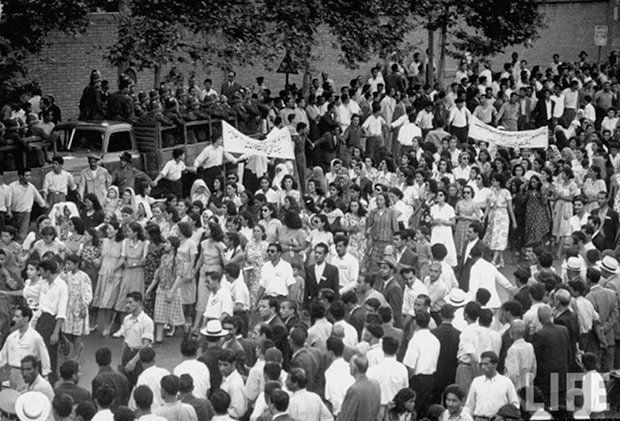2. The dramatization of femininity in gay culture
As opposed to the strong feminist movement in the West—which in the 1970s in the entirety of Eastern Europe only came powerfully to life in Belgrade and Zagreb, Slovenia had to wait for its feminist coming-out until the 1980s, a time of strong subcultural and rock ‘n’ roll movements in Ljubljana, and this happened through performative actions that can be identified as gay, lesbian, (post-)punk, sexual, and queer.
It is possible, therefore, to establish a different historization of the former Yugoslavia between feminism and artistic, cultural, social, and theoretical-critical practices. If it was possible in the 1970s to activate feminism as a powerful tool within academic and conceptual art structures in Zagreb and Belgrade, in the 1980s, “feminism” developed as a theoretical and activist practice only in connection with other marginalized but powerfully “revolutionary” interventions. In the 1980s this happened in relation to punk and post-punk as well as in relation to visual culture in the gay community, and underground alternative music and video productions. Feminist positions in connection with gay, lesbian, and transvestite situations were performed and replayed in front of the video camera or on the stage in works by groups such as Meje kontrole št. 4 (The Borders of Control no. 4) and Borghesia, both from Ljubljana. Performances connected with pornography, sadomasochism, and other marginalized sexual practices presented a clear political investment in the space of performance and new media (film, video). 1
The Borders of Control no. 4, Ljubljana
The first work produced in the 1980s within these horizons of thought, and imbued with the ideology of the underground was Icons of Glamour, Echoes of Death (Ikone glamourja, odmevi smrti), from 1982. The author was the group, “The Borders of Control no. 4.” 2 The video is about the phantasmatic world of a woman, portrayed as a fashion model, and her friend, a hermaphrodite (we discover this in the end of the video when the phallus between her legs emerges). The model, on the other side, is apparently a transvestite, changing gender easily through language. They remember their childhood, their years in school, and their first experiences with masturbation. The visual story in the video presents the confrontation of the model with her photographs and slides. She is playing “live” for the camera, while restaging her poses in the photographs projected in the background. The model poses while we follow the captions of the song The Model (the original lyrics by Kraftwerk interpreted by Snakefinger). 3 The video reuses and applies the aesthetics of German and American avant-garde traditions from the 1960s and 1970s in its lighting, camera, and editing, referring to Fassbinder, Von Praunheim, and Warhol. The performance in front of the camera points to the politics of sexuality and female pleasure. This work was one of the first under socialism that opened up and dramatized the institutions of masculinity through drag and king practices. It can be seen as a clear political statement in favor of lesbians through queer optics.
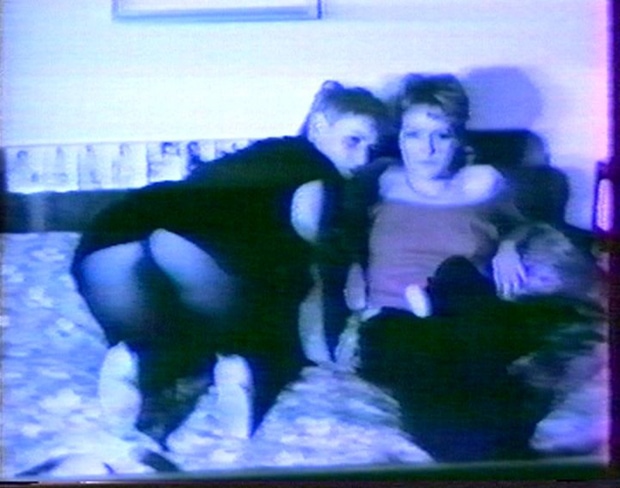
It is possible to make a direct correlation to another work in the “West,” to Linda Benglis’ notorious advertisement in the November 1974 issue of Artforum. She called attention to herself by posing naked with a dildo (a plastic prosthesis). The dildo takes the central role in both works: in Benglis’ advertisement and in the video work by The Borders of Control.
When the woman is with the phallus, this phallus is not an object, but a signifier. It inverts the order and role of the gaze. With this move, we can say that a precise anticipation of queer strategies was brought into the socialist context (in the underground). The gendered body is made visible through a signifier. And why is this so important? In order to reclaim feminism and its power for ourselves, it is important to differentiate between heterosexual, transvestite, lesbian, and queer, feminine sexuality—not to hybridize, but to demonstrate the power of these differentiations for feminism. It is equally important to see the transformation from a woman as sign (as was the case for Vlasta Delimar) to a woman as signifier. The signifier performs the subject not just as image, but as discourse, through language, where this discourse is also a critique of the language of the institutions of culture, technology, the social, and the political.
In the 1990s, Judith Butler and Eve K. Sedgwick therefore delivered their definition of gender in terms of performance art. This is one of the reasons for this proposed genealogy! But I would like to advance a thesis that in the East (of Europe), the result of this process of performance agency was the production and reinvention of the political subject in art. The queer body was, in the East, eminently and thoroughly the political body that presented itself as a move from the sexual toward the political queer. This was also connected with the structure of socialism or communism, that in opposition to a hysterical and neurotically configured libidinal space of capitalism—which lives from a constant becoming, changing, and reinventing of identities, and takes parody as its primal aesthetical form—socialism and its big brother, communism, were psychotic spaces. Communism was a psychotic, autistic system where everything was directly connected with ideology, without the art and culture market that is the main regulator of the never-ending, neurotic, and hysterical processes of becoming in capitalism (you can ask yourself, why gender is suddenly so fashionable). The result in socialism was the production of strategies and tactics beyond parody; over-identification being one of the most notorious. Of course, life under capitalism is connected with ideology (especially when capitalism claims that we are living in postideological times), and through bypass, it is “facilitated” by the market, consumerism, and by forced enjoyment with forms of life that are constantly reinvented.
3. The dramatization of masculinity in the queer context
The dramatization of masculinity in the postsocialist context initiated a different attitude toward feminism and performance. Seen through a queer context in the former East, it is a strategy with which to perform the ownership(s) of masculinity. What does this mean? It means to question, through performance within sexual and libidinal contexts, the institution of contemporary art and culture and its (new) proprietary relations in society. It means to question new forms of private ownership of art and culture, the social and the political, as the innermost motor of contemporary, global-capitalist, neoliberal societies. Surplus value is at the core of capital, and it is in correlation with surplus enjoyment (with more and more forms of life, products, identities, etc.) Within such a context, it is possible to articulate private property relations concerning history, intellectual property (copyright for example), etc., as directly connected to the contemporary institution of masculinity. Are we not today witnessing art projects that have several fathers or owners who establish the brands (the Documenta(s), the Balkan exhibition series in Germany and Austria in 2003 and 2004, etc.)? All these new paternalistic figures make apparent that they are behaving as dictators, imposing the absolute right of decisions. New proprietary relations are established for the protection of capitalist property rights, leading to the increasingly privatized ownership of different public projects, exhibitions etc.
Tanja Ostojić, Belgrade

A photograph titled Black Square on White was taken in the 1990s, featuring the black pubic hair of performer Tanja Ostojić styled in the form of a “Malevich” square (a black square centered in the middle of a white plane), and organized in a composition with her white skin, the Mound of Venus.
Kasimir Malevich’s Black Square is one of the most famous creations of Russian art in the last century. The first Black Square was painted in 1915, beginning a turning point in the development of the Russian avant garde. Black Square against a white background became the symbol, the basic element in the system of the art of suprematism, the step into the new art. Being one of the elementary forms, the square embodied the idea of collective work that was of great importance to Malevich.
Between Ostojić’s legs, the real/impossible kernel of the art power machine received its only possible appearance in flesh and blood. The so-called touchy nodal point of contention in art today is the cannibalistic attitude of art’s edifice of capitalist power that displaced, abstracted, and expelled everything and everybody for the sake of its own survival. Works of art are completely abstracted from their historical roots by the capitalist art market. Malevich stands at the beginning of an art-historical edifice that is completely detached from its conditions of possibility—that means this history is presented as detached from any social, political, and economic contexts. What we see is a complete disembodiment that suits disembodied, neoliberal capitalist democracy perfectly. And if we are to rearticulate the ways that this real/impossible kernel is to emerge today in the field of (performance) art, then it is possible only as tropological/topological incarnation(s). In Tanja Ostojić’s work it is precisely the pubic Malevich under the stylish gowns: that is, the black square embodied on the topological place, and not some kind of “wallpaper, poster Malevich.” What else is Ostojić’s Black Square on White, if not a tropological incarnation on a topological place? This work serves as a fleshy (incarnated) embodiment of the total expulsion of the condition of possibility from the capitalist edifice of modern art.
The ontology of gender is, according to Jacqueline Rose, a partial identification as identification in process, a flux that never stops. But what we have here is over-identification. Ostojić does not present a kind of partial identification, as is the case in parody—a mockery that starts with identification, but then becomes a joke. With over-identification we witness an ultraorthodoxy. Tanja Ostojić performs the publicly unspoken ideology of contemporary art literally and until the end, in order to articulate the libidinal dynamics of capitalism.
Let’s take another example from in between Tanja Ostojić’s legs. Tanja Ostojić’s untitled work (after Gustave Courbet) from 2004, which measured 46 by 55 centimeters, and was presented in Camera, Austria, Graz in 2005, and in public space in Vienna in 2006, as part of the European Union meeting of state presidents. It was removed after protests by politicians and publics concerned with “genuine” human rights.
Ostojić’s work reconstructs Gustave Courbet’s painting, The Origin of the World from 1866, of the same dimensions. The difference between these two works is of crucial importance. In Courbet, transgression is abstracted in the name of aesthetic enjoyment. Courbet’s visualization, as argued by Šuvaković, can be seen as a confirmation of him as a master not only in possession of the gaze (the male gaze of nineteenth century), but of the most intimate parts of a woman’s body as well. Ostojić returns this gaze by pointing to the core of another origin, to the origin of the European Union that resides in libidinal and biopolitical organizations and differentiations; that hegemonizes, sorts, and regulates the social, economic, and administrative body of Europe; and that is becoming what critics have called “Fortress Europe.”
We can make another comparison, this time with one of the canonical works of conceptualism. Vito Acconci in his 1970 work, Corrections hides his genitals, with the outcome being a black triangle. The triangle and the square? Is this just about geometry? Or is it politics? Acconci’s work was performed in the time of high modernism, when white male artists did not need to think about the nature or borders of their gender; the Other was just the “painting” or the body (just think about Vienna Actionismus). Acconci’s triangle, the result of his hidden genitals, presents a zero position, or, according to Šuvaković, it is gender apolitical. He does not need to situate his “knowledge,” or, as Lacan would say, his “ignorance.” For conceptual art in Western high modernist times, the white male body was “enough” and did not need any text!
Ostojić’s works challenge the desexualized and therefore depoliticized subject, and the disembodied notion of citizenship within neoliberal capitalist democratic society. Diane Torr (in Preciado’s text) argues that with such projects, we see the possibility of creating, through theatrical/performative reappropriation of the ownership of masculinity, a new territory for experiencing/contextualizing and politicizing the body. This has been, according to Torr, denied to women by a politically correct distribution of gender. A drag king theatrical personification of masculinity generates, according to Torr, a redefinition of the borders between private and public, transforming the space of political and sexual action of the body into a political statement that tackles the core of the capitalist machine: private property and ownership of bodies, art works, spaces, patents, knowledge, and political rights. In the context of the East (of Europe), one might say: transforming the sexually queer into the politically queer.
Šejla Kamerić, Sarajevo
A different story emerges in Šejla Kamerić’s Bosnian girl, from 2003. A photograph of Šejla Kamerić is presented as a poster covered with a text depicted in a graffiti style that says, “No teeth…? A moustache…? Smell like shit…? Bosnian Girl!”
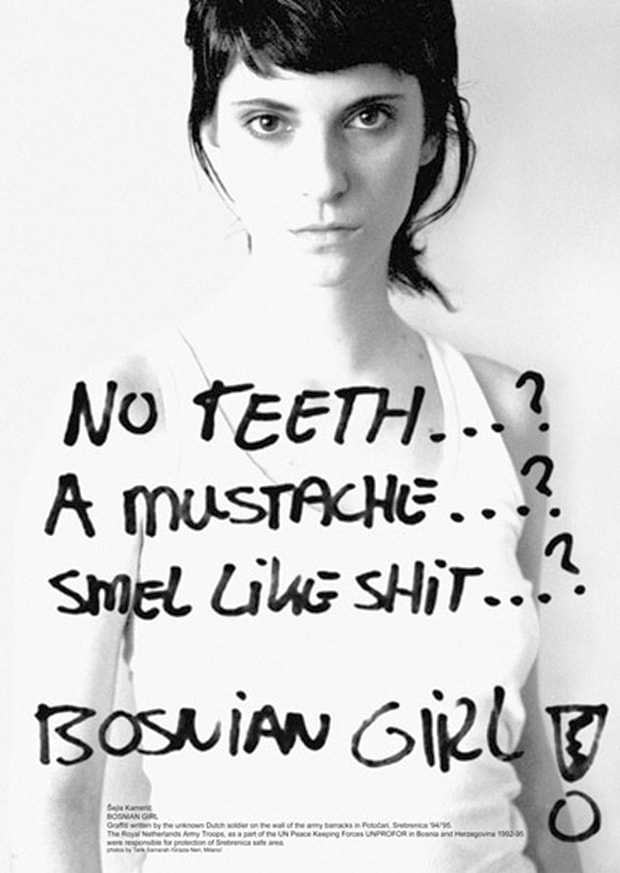
The bottom of the poster contains a traumatic footnote that is the real: “This text was written by an unknown Dutch soldier on the wall of the army barracks in Potočari, Srebrenica 1994/1995. The Royal Netherlands Army Troops, as a part of the UN Peace Keeping Forces UNPROFOR in Bosnia and Herzegovina 1992–95 were responsible the for protection of the Srebrenica safe area.” With this “intrusion” of politics into what seemed like an emotional statement, the trauma becomes visible. The trigger in this work is the reference to where the graffiti was taken from. It presents the transformation, the passage from the abject (something that is neither a sublime object nor a piece of shit) toward the object small a, that in theoretical psychoanalysis is the symptom; as such, it surpasses the agenda of feminism as micropolitics, presenting it as social contradiction, or antagonism. Similarly to sexual difference, social contradiction cannot be symbolized or presented as a relationship—it remains as the traumatic real in society. In Kamerić’s work, the footnote points to a set of homophobic, chauvinistic, and racist prejudices that were/are part of the institution of UNPROFOR in the former Yugoslav territory and of West European policy in the Balkans.
The politics of performing gender through queer subjectivity means finishing with micropolitics and individual storytelling, and pointing a finger to a social antagonism that organizes the entire space of Europe, or presents it through its most traumatic points of failure (for example, European peacekeeping forces and the European policy for establishing order in the Balkan wars).
Eclipse, Ljubljana
Eclipse is a female duo that first exhibited publicly in 1999. One of the members of the duo always performs in front of the camera, as the kitschy porno-functional body, while the other is behind it. The body in Eclipse is constantly being produced through performative actions. In Eclipse’s photograph titled Blood is Sweeter Than Honey, from the 2001 series Pornorama, we see a performer lying naked as if in some Renaissance painting, but not in a green meadow like a Venus, but on an old medical table from the beginning of the previous century used to transport patients and corpses to surgery. Her naked, attractive, and kitschily adorned body is transformed into a map that presents the body as territory, where body parts—breasts, neck, legs, arms—are secured and territorialized with numbers. The photograph also has a legend in which each number is ascribed a name of a well-known artist: Koons, Almodovar, Abramović, Sprinkle, Madonna, etc. The photograph is displayed as a map of the body dismembered by contemporary artists, branded, and owned by the Institution (by the Market) of Contemporary Art—Abramović is connected with arms, after she so obsessively cleansed the bones of war in the former Yugoslavia at the 1997 Venice Biennale; Almodovar with heels (after his film High Heels), etc. These artists already claimed certain parts of the body through the capitalist art market that regulates and distributes the selling and consumption of images.
The result of Eclipse’s work is to show that the master artist, with her or his cannibalistic attitude toward one part of the body, loses part of his or her priority and originality, precisely by being dismantled through Eclipse’s recycling and parodying of models of femininity and masculinity from the high-arts field and displayed as popular trashy postsocialist doubles.
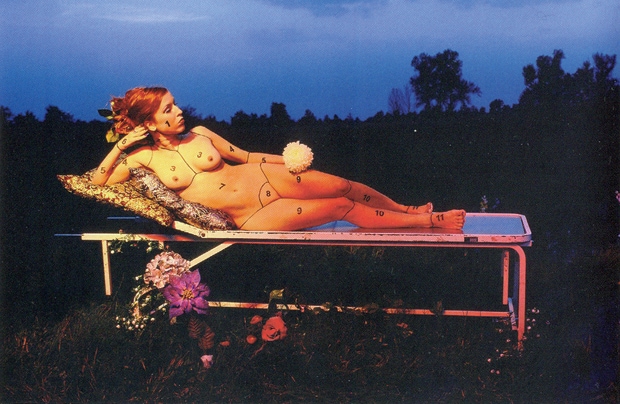
The body is a map with the name of a well-known artist ascribed to each number:
1. Jeff Koons; 2. David Cronenberg; 3. Madonna; 4. Marina Abramović; 5. Chapman Brothers; 6. Richard Clayderman; 7. Jan Saudek; 8. Annie Sprinkle; 9. Helmut Newton; 10. Ron Athley; 11. Pedro Almodovar
Queer performance and performative politics dismantle binary oppositions (being of sexual or political character) by questioning institutions of power and their proprietary relations; and in such a way, producing a space for political battles, and creating agency for the political transfeminist subject capable of developing alternatives not only to art and culture, but society and politics as well.
- See Marina Gržinić, Fiction Reconstructed. Eastern Europe, Post-socialism and the Retro-avant-garde (Vienna: Edition selene, 2000).[↑]
- The two members of the group who perform in this video are Marina Gržinić and Aina Šmid.[↑]
- “For every camera, she gives the best she can / I even saw her on the cover of a magazine / Now she’s a big success I want to see her again.” Original lyrics by Kraftwerk, “The Model,” The Man-Machine, Kling Klang, 1978.[↑]

